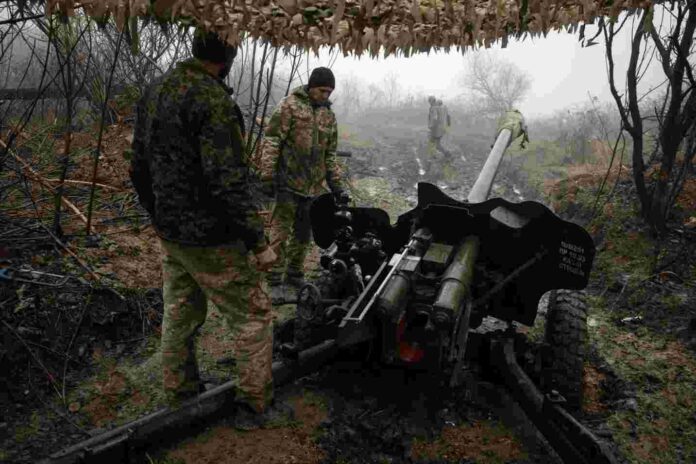
U.S. and Ukraine Navigate Strategies Introduction
The geopolitical landscape witnessed a seismic shift as the joint U.S. and Ukraine counteroffensive failed to achieve its anticipated objectives. This article delves into the repercussions of this setback, examining how both nations are recalibrating their strategies to navigate the complex web of international relations and regional stability.
Recapitulation of the Counteroffensive
Objectives and Initial Expectations
The counteroffensive was conceived with ambitious objectives, aiming to reclaim strategic territories and assert dominance. Initial expectations were high, fueled by a combination of military prowess and technological superiority.
Key Tactical Approaches
Tactical approaches included precision airstrikes, cyber warfare, and ground offensives. The integration of cutting-edge military technologies was intended to provide a decisive edge.
Unforeseen Challenges and Setbacks
However, unforeseen challenges emerged, ranging from resilient enemy tactics to logistical issues. The intricate nature of modern warfare showcased the need for adaptive strategies in the face of unpredictability.
Geopolitical Ramifications
Impact on Regional Stability
The repercussions of the failed counteroffensive reverberated beyond national borders, destabilizing the region and necessitating a reevaluation of diplomatic relationships.
International Response and Alliances
Global alliances shifted in response to the geopolitical landscape, prompting both support and criticism. The U.S. and Ukraine found themselves in a delicate dance of diplomacy to maintain international partnerships.
Economic Implications for Both Nations
Economic stability became a casualty of the failed offensive, prompting a review of trade agreements, sanctions, and economic partnerships. Both nations faced the challenge of mitigating economic fallout while maintaining strategic interests.
U.S. and Ukraine Reevaluating Military and Tactical Approaches
Lessons Learned from the Counteroffensive
A comprehensive analysis of the counteroffensive yielded valuable lessons. The need for adaptable strategies, intelligence integration, and a holistic approach to warfare became evident.
Technological Advancements and Integration
Investments in emerging technologies and their seamless integration into military operations emerged as a focal point. The pursuit of technological superiority became synonymous with strategic resilience.
Strengthening Collaborative Training Programs
Military collaboration expanded beyond joint operations, emphasizing the importance of collaborative training programs. Shared knowledge and experience became indispensable in preparing for future challenges.
Diplomatic Initiatives in the Post-Counteroffensive Era
Engaging International Mediation
Diplomatic channels were explored to seek international mediation, fostering dialogue to de-escalate tensions and redefine diplomatic relationships.
Leveraging Multilateral Organizations
Multilateral organizations provided platforms for dialogue and conflict resolution. The U.S. and Ukraine navigated the intricate web of international diplomacy to garner support and forge alliances.
Assessing Diplomatic Leverage and Soft Power
Diplomatic strategies focused on leveraging soft power, influencing global opinion, and utilizing diplomatic leverage to secure favorable outcomes on the international stage.
Economic Strategies Amidst Geopolitical Uncertainty
Diversifying Economic Alliances
Both nations actively sought to diversify economic alliances, reducing dependency on specific trade partners and minimizing economic vulnerabilities.
Mitigating the Impact on Trade and Investments
Economic strategies aimed at mitigating the impact on trade and investments involved renegotiating agreements, exploring new markets, and implementing measures to safeguard economic interests.
Exploring Innovative Economic Partnerships
Innovation emerged as a key driver for economic resilience. Exploring new economic partnerships and fostering innovation became essential components of the economic recovery strategy.
Propaganda and Information Warfare
Analyzing the Role of Information Dissemination
The role of information dissemination in shaping public opinion and international perspectives was scrutinized. U.S. and Ukraine Strategic communication became paramount in the battle for narratives.
Countering Disinformation Campaigns
Efforts were intensified to counter disinformation campaigns, employing advanced technologies and collaborative intelligence to dismantle false narratives and preserve the truth.
Leveraging Public Relations for Positive Narratives
Public relations played a pivotal role in reshaping narratives. The U.S. and Ukraine sought to project resilience, determination, and a commitment to shared values through strategic PR campaigns.
U.S. and Ukraine Domestic Preparedness and Resilience
Strengthening National Security Infrastructure
National security infrastructure underwent enhancements to address vulnerabilities exposed during the counteroffensive. The focus shifted to bolstering cyber defenses, intelligence capabilities, and critical infrastructure protection.
Enhancing Civilian Preparedness and Awareness
Civilian preparedness became a cornerstone of resilience. Initiatives to enhance public awareness, emergency response training, and community resilience were prioritized.
Balancing Civil Liberties and National Security
The delicate balance between civil liberties and national security came under scrutiny. Governments grappled with the challenge of maintaining security without compromising individual freedoms.
Intelligence Collaboration and Fusion
Integrating Intelligence Resources
The post-counteroffensive era saw a concerted effort to integrate intelligence resources. Cross-agency collaboration and information sharing became imperative to anticipate and counter emerging threats.
Strengthening Information Sharing Mechanisms
Information-sharing mechanisms were streamlined to facilitate seamless collaboration between intelligence agencies. The synergy aimed to create a comprehensive and real-time intelligence picture.
Addressing Challenges in Collaborative Intelligence
Challenges in collaborative intelligence were addressed through enhanced communication protocols, standardized procedures, and the development of a shared intelligence language.
Public Opinion and National Morale
Communicating Transparently with the Public
Transparent communication emerged as a cornerstone of rebuilding public trust. Governments prioritized open and honest communication to provide citizens with a clear understanding of the situation.
Fostering National Unity and Resilience
National unity became a rallying point. Governments sought to foster a sense of resilience and shared purpose among citizens, emphasizing collective strength in the face of adversity.
Building Confidence in Government Actions
Government actions were scrutinized, and efforts were made to build confidence through effective policies, crisis management, and responsive governance.
Long-Term Strategic Planning
Assessing Long-Term Threats and Challenges
Strategic planning extended beyond immediate concerns, incorporating a thorough assessment of long-term threats and challenges. Governments worked towards creating adaptive strategies for an ever-evolving geopolitical landscape.
Developing a Sustainable Strategic Vision
The pursuit of a sustainable strategic vision became paramount. Governments aimed to align national interests with global stability, ensuring a resilient and adaptable approach to future challenges.
Adapting to Evolving Geopolitical Dynamics
Flexibility in strategy emerged as a key theme. Governments acknowledged the fluid nature of geopolitical dynamics, emphasizing the need for continuous adaptation and foresight.
Conclusion
Synthesizing the New Strategy
The U.S. and Ukraine stand at the crossroads of change, synthesizing a new strategy forged through the crucible of challenges. This adaptive approach seeks to navigate the complexities of modern geopolitics.
Embracing Adaptability and Innovation
The journey towards a new strategy embraces adaptability and innovation as guiding principles. In an ever-changing world, the ability to pivot and innovate becomes the bedrock of sustained success.
The Path Forward: U.S. and Ukraine Collaboration in a Dynamic Global Landscape
As the dust settles from the failed counteroffensive, the U.S. and Ukraine embark on a shared path forward, navigating the intricacies of a dynamic global landscape with resilience, diplomacy, and strategic acumen.



